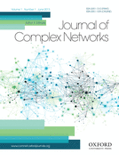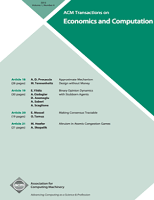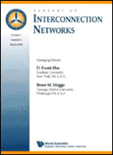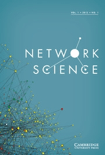
Journal of Complex Networks
Scope & Guideline
Exploring the Intricacies of Network Dynamics
Introduction
Aims and Scopes
- Network Theory and Dynamics:
The journal explores the fundamental principles of network theory, including the study of network topology, dynamics, and evolution across various domains such as social, biological, and technological networks. - Centrality and Influence Measures:
Research on centrality measures, node influence, and their implications in networked systems is a core area. This includes the development of new algorithms and metrics to better understand the role of individual nodes within complex networks. - Community Detection and Structure:
A significant focus is placed on community detection methods, analyzing how nodes cluster within networks, and the implications of these structures for network behavior and dynamics. - Higher-Order Networks:
The journal places emphasis on higher-order interactions and the study of hypergraphs, which extends beyond traditional pairwise interactions to capture more complex relationships. - Applications in Real-World Systems:
Research is applied to real-world systems, including epidemiology, social media, and infrastructure networks, providing insights into network behavior and potential interventions. - Computational Methods and Models:
The use of advanced computational techniques and models, including agent-based modeling, machine learning, and statistical inference, is prevalent, allowing for robust analyses of complex systems.
Trending and Emerging
- Multilayer and Multiplex Networks:
There is an increasing interest in multilayer and multiplex networks, which reflect the interconnectedness of different types of relationships and layers within complex systems. - Temporal Dynamics and Evolution:
Research is increasingly focusing on the temporal aspects of networks, including how networks evolve over time and the dynamics of interactions within those networks. - Higher-Order Interactions:
The exploration of higher-order interactions, such as those represented in hypergraphs and simplicial complexes, is gaining traction, reflecting a deeper understanding of complex relationships. - Machine Learning and AI Applications:
The integration of machine learning and artificial intelligence techniques in network analysis is on the rise, showcasing new methodologies for predicting behaviors and identifying patterns. - Resilience and Robustness Studies:
Emerging research is concentrating on the resilience and robustness of networks against failures and attacks, highlighting the importance of understanding vulnerabilities in complex systems. - Interdisciplinary Approaches:
There is a growing trend towards interdisciplinary research that combines insights from sociology, biology, computer science, and economics to address complex problems within network frameworks.
Declining or Waning
- Traditional Graph Models:
Research focused exclusively on traditional or simplistic graph models is becoming less common. The trend is shifting towards more complex models that account for higher-order interactions and dynamics. - Basic Statistical Analysis:
There is a noticeable decline in papers that employ basic statistical approaches without integrating advanced computational methods or new theoretical frameworks. - Static Network Analysis:
Studies that analyze networks in a static context, ignoring temporal dynamics and evolution, are less frequently published. There is a growing recognition of the importance of considering time-varying aspects in network analysis. - Single-Domain Applications:
Research that is limited to single-domain applications, such as purely social networks without interdisciplinary connections, is seeing a decrease in favor of more integrative studies that span multiple domains. - Overly Simplistic Community Detection Algorithms:
The journal is moving away from simplistic community detection methodologies that do not consider complexities such as overlapping communities or dynamic changes in network structure.
Similar Journals

ACM Transactions on Economics and Computation
Transforming Economic Research with Computational PrecisionACM Transactions on Economics and Computation, published by the Association for Computing Machinery, is a premier scholarly journal that bridges the fields of economics and computation. With an ISSN of 2167-8375 and an E-ISSN of 2167-8383, this journal has carved out a significant niche since its inception in 2013, and is set to run through 2024. Its multidisciplinary scope encompasses various quarters, being ranked Q1 in Computer Science (miscellaneous) and Q2 in Computational Mathematics, Economics and Econometrics, Marketing, and Statistics and Probability as of 2023. The journal not only ranks impressively in Scopus—positioned within the top 25% for several categories—but also fosters a collaborative environment where researchers, professionals, and students can engage with cutting-edge research that showcases innovative methodologies and theoretical advancements. Although it is not open access, the journal remains vital for advancing knowledge at the intersection of computation and economics, making it an essential resource for those looking to understand the complexities of these dynamic fields.

International Journal of Wireless Information Networks
Leading the Charge in Wireless Information ResearchInternational Journal of Wireless Information Networks, published by Springer, is a premier outlet for scholarly research in the fields of wireless information and communication technologies. With an ISSN of 1068-9605 and an E-ISSN of 1572-8129, this journal has established itself as a significant contributor to the literature since its inception in 1994. As evaluated in 2023, it holds a commendable Q2 ranking in several categories, including Computer Networks and Communications, Electrical and Electronic Engineering, and Hardware and Architecture, reflecting its robust impact and relevance within the academic community. Furthermore, it is ranked within the top quartiles in Scopus, placing it in the 76th, 74th, and 73rd percentiles in relevant fields. While the journal does not currently offer open access options, it remains an essential resource for researchers, professionals, and students dedicated to advancing knowledge and innovation within wireless information networks. The authoritative content published within these pages positions the journal at the forefront of ongoing technological developments, making significant contributions to the field until at least 2024.

Big Data Mining and Analytics
Pioneering Research in Data-Driven SolutionsBig Data Mining and Analytics, published by TSINGHUA UNIVERSITY PRESS, stands at the forefront of interdisciplinary research in the fields of Artificial Intelligence, Computer Networks and Communications, Computer Science Applications, and Information Systems. With an impressive Q1 ranking in multiple categories as of 2023, this journal serves as a critical platform for researchers and professionals eager to explore innovative techniques and methodologies related to big data analytics. Since its transition to Open Access in 2018, Big Data Mining and Analytics has aimed to increase the visibility and accessibility of its cutting-edge research, making permanent strides in the global academic landscape. Housed in Beijing, China, and actively embracing the converged years from 2018 to 2024, the journal aims to cultivate a rich discourse on emerging trends and applications, ensuring its relevance in a rapidly evolving technological environment. Join a vibrant community of scholars dedicated to advancing the frontiers of knowledge in big data.

JOURNAL OF INTERCONNECTION NETWORKS
Connecting Ideas, Bridging NetworksJOURNAL OF INTERCONNECTION NETWORKS, published by World Scientific Publishing Co Pte Ltd, serves as a vital platform for researchers and professionals in the field of computer networks and communications. Established to foster an understanding of interconnection networks, this journal showcases innovative research findings, methodologies, and advancements in the domain. With an ISSN of 0219-2659 and an E-ISSN of 1793-6713, it has navigated through critical periods of publication, capturing the evolution of the field from 2008 to 2013 and from 2015 to 2023, albeit with discontinued coverage in Scopus. Although currently listed in the Q4 category for Computer Networks and Communications, the journal provides unique insights that contribute significantly to the growing body of knowledge in this niche area, appealing to academics, industry practitioners, and students alike. Please note that the journal operates under traditional subscription-based access options. Engaging with the JOURNAL OF INTERCONNECTION NETWORKS will undoubtedly enhance your understanding and stimulate further exploration within the increasingly important landscape of computer networking.

Social Network Analysis and Mining
Transforming Data into Meaningful ConnectionsSocial Network Analysis and Mining, published by SPRINGER WIEN, is a premier journal dedicated to the advanced study and application of social network analysis and data mining methodologies within the fields of communication, computer science, and media technology. With rigorous peer-review standards and a 2023 category ranking within the Q1 quartile for Communication and various Q2 rankings across Computer Science and Human-Computer Interaction, this journal not only highlights cutting-edge research but also influences current trends and methodologies in the discipline. The journal's articles are accessible through subscription, ensuring a broad reach among academic institutions and professionals. Covering converged years from 2011 to 2024, Social Network Analysis and Mining serves as an essential resource for researchers, practitioners, and students seeking to deepen their understanding of social networks’ roles in information systems and digital communication, reflecting significant insights from its Scopus rankings that position it at a high percentile among related fields.

Network Science
Innovating the study of networks across disciplines.Network Science is a distinguished journal published by Cambridge University Press, dedicated to advancing our understanding of complex networks across various domains, including communication, sociology, and psychology. Since its inception in 2013, the journal has consistently aimed to provide a platform for groundbreaking research that explores the structure and dynamics of networks, thereby facilitating interdisciplinary collaboration and innovation. With an impressive ranking in the Q2 category for Communication and Sociology, and Q3 for Social Psychology, Network Science has carved out a significant niche within the academic community, reflected in its reputable metrics—ranking #112 out of 511 in Communication and #333 out of 1466 in Sociology and Political Science according to Scopus. The journal plays a pivotal role in shaping the landscape of network theory and analysis, making it an essential resource for researchers, practitioners, and students eager to delve into the intricate relationships that underpin social systems. Access to this journal fosters an environment of scholarly exchange and stimulates further research in the rapidly evolving field of network studies.

Complex Systems
Bridging Disciplines to Decode ComplexityComplex Systems is a pivotal journal published by Complex Systems Publications Inc, specializing in the interdisciplinary field of complex systems science. With an ISSN of 0891-2513, it focuses on advancing the understanding of complex phenomena across various domains, including computer science and control engineering. Operating from the United States, this journal has established itself as a credible source with a current impact factor reflecting its relevance—ranking in the Q3 category for both Computer Science (miscellaneous) and Control and Systems Engineering as of 2023. Although it does not offer Open Access, Complex Systems aims to facilitate the exchange of cutting-edge research and innovative methodologies, making it indispensable for researchers, professionals, and students eager to explore and contribute to the field. With coverage spanning from 2012 to 2024, it strives to foster a deeper understanding of the principles governing complex systems, thus paving the way for future technological advancements and theoretical developments.

Engineering Letters
Unleashing Creativity in the Engineering LandscapeEngineering Letters, published by NEWSWOOD LTD, is a prominent journal in the field of engineering, focusing on innovative research and interdisciplinary studies that reflect the current trends and applications in the engineering landscape. With an ISSN of 1816-093X and an E-ISSN of 1816-0948, this open-access journal strives to provide a platform for researchers, professionals, and students to disseminate insights and findings that contribute to engineering knowledge. Based in Hong Kong, Engineering Letters has maintained a respectable standing with a 2023 Q3 quartile ranking in the miscellaneous category of engineering and ranks #142 out of 307 in general engineering according to Scopus, signifying its influence with a 53rd percentile ranking. The journal’s convergence years, spanning from 2009 to 2024, encapsulate an evolving landscape of engineering discussions and innovations, aimed at fostering collaborations and inspiring the next generation of engineers.

WIRELESS NETWORKS
Pioneering Innovations in Network TechnologyWIRELESS NETWORKS is a prestigious journal published by Springer, focusing on cutting-edge research in the domains of wireless communication, computer networks, and information systems. Established in 1995 and set to converge its influential contributions until 2024, this journal has rapidly ascended to a Q2 category ranking in the fields of Computer Networks and Communications, Electrical and Electronic Engineering, and Information Systems, reflecting its significant role in advancing knowledge and innovation—ranked 75th, 151st, and 84th respectively in their fields by Scopus. Researchers and professionals alike value its contribution to the discourse on wireless technologies, making it a vital resource for professionals and students eager to stay abreast of the latest trends and findings. Although it does not offer open access, the insights gleaned from its articles are invaluable for tackling the challenges of modern communications and ensuring the efficient use of wireless networks.

Ad Hoc & Sensor Wireless Networks
Inspiring breakthroughs in wireless communication.Ad Hoc & Sensor Wireless Networks, an esteemed journal published by OLD CITY PUBLISHING INC, provides a dedicated platform for the dissemination of pioneering research in the realms of computer science, electrical and electronic engineering, and instrumentation. With an ISSN of 1551-9899 and an E-ISSN of 1552-0633, this journal has established itself as a crucial resource for scholars and practitioners alike, actively contributing to the advancements in ad hoc networks and wireless sensor technologies. It holds a commendable position within the third quartile in its respective fields, with Scopus rankings reflecting its relevance in the academic community. As a publicly accessible source of valuable insights, the journal aims to inspire innovation and facilitate progress across various disciplines. Situated in Philadelphia, PA, and converging its efforts from 2005 to 2024, Ad Hoc & Sensor Wireless Networks continues to be a beacon of research excellence, impacting both theoretical and practical domains in technology.